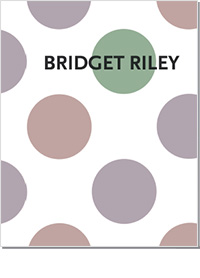 |
|
|||
Bridget Riley: Measure for Measure. New Disc Paintings English Hardcover
|
More than half a century after her first groundbreaking works of Op Art in the early 1960s, Bridget Riley is still working on the edges of perception, exploring the interactions of form and colour in her paintings. For her 2017 exhibition at Galerie Max Hetzler in Paris, titled Measure for Measure, she installed eight canvases and two wall works, one of them more than four meters wide. In these works, all part of her series of Disc Paintings (2016–2017), coloured discs are arranged in a diagonal grid, their palette – a greyed off-green, off-violet, and off-orange – inspired by pointillist artist George Seurat. The colours oscillate depending on the neighbouring hues and their position within the grid, lending each work a different mood. The series is both “a result of Riley looking one more time at Seurat” and an “exploration of the visual effects obtained by the repetition on a limited surface of discs which vary only in colour”, as Éric de Chassey points out in his richly illustrated essay. He outlines Riley’s developing interrogations involving first black and white, then coloured discs during various work phases.
THE PLEASURES OF PERCEPTION Each Measure for Measure painting is a tour de force in mastering the chromatic divergences, so that they don’t rip apart the unity of a composition in establishing diversity into unity, and vice-versa. Riley had tried to do so in her earlier Circles Colour Structure Studies 1970/71 through the concentric enclosure of smaller discs inside larger circles, explaining then: “It is very important that each form finally relinquishes its separateness in the whole. It must be fully absorbed. So while it is necessary in the early stages to analyse each unit, my aim is to enable it to release sufficient energy to precipitate its dissolution in totality.” This encircling was enough to establish diversity without letting it go astray, as already proven against the extreme regularity of the placement of black and white concentric circles in Dilated Centres (1963). The Measure for Measure series is proof that Riley is now able, through careful and intuitive placement of each greyed colour in an extremely regular composition, made of identical shapes, to work with separate forms that never relinquish their identity while never destroying the unity of the whole. On the contrary, the coloured circles, through a combination of regular repetition and specific variation, build up that unity from their separateness… In the square format of the Measure to Measure paintings and the two contemporary square wall paintings, there is no privileged direction, even if, because of the numbers of discs chosen, there is always a centre disc. Depending on the way I look at the painting, it appears centrifugal or centripetal (the square format also ensures that there is no spilling of the image onto the borders, that is to say the mind does not continue what it has learned inside the motif). It establishes a relationship to the body of the viewer: if I come close, I see most discs as a peripheral halo; if I step away, it performs as a picture (un tableau). The horizontal rectangular murals are much less centred, and they veer between stability and instability, agitation and harmony, anxiety and composure, depending on the way and the moment we look at them. The discs bump and bang, as if they were billiard balls or atoms, although fully bidimensional, and then they seem to be creating static patterns that our gaze isolates and combines to build a global field. They model organised randomness or random organisation, which is very much like our lives: no centre, no centres, except in the sense that each disc always reads as a centre for our vision, around which the surrounding discs organise themselves; only axes.
... |